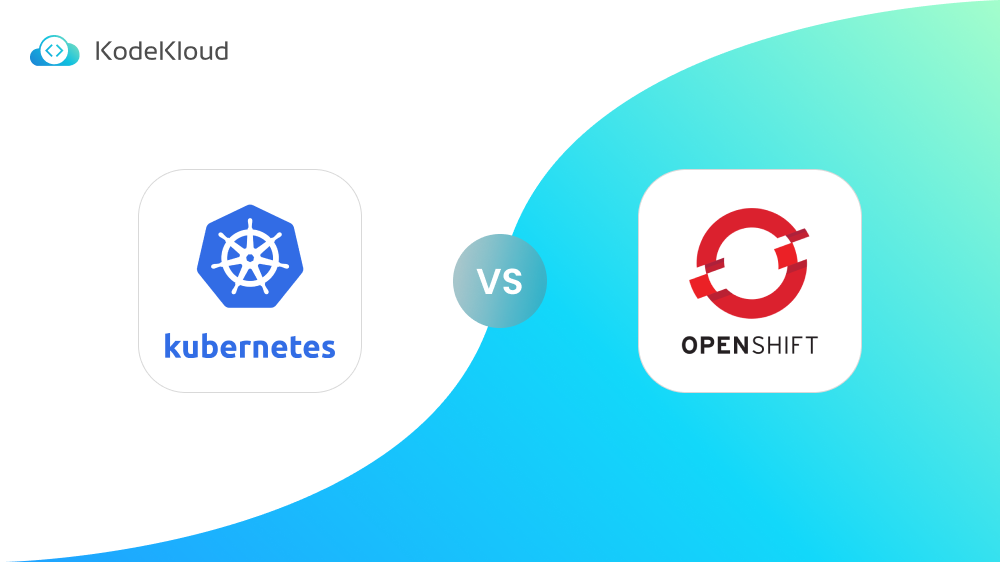Containerization is a modern technology that has drastically transformed the software deployment process. It involves packaging software applications and all their dependencies into a single, self-contained unit known as a container. To leverage containers effectively, you need a tool to help manage and deploy them - otherwise known as orchestration.
This article discusses two popular open-source container orchestration tools: Kubernetes and OpenShift. While they share some similarities, some key differences set them apart. Let's look at how each work and their key differences.
What is Kubernetes (K8s)?
Kubernetes is an open-source container orchestration platform that automates containerized applications' deployment, scaling, and management. It provides a highly scalable and reliable way to manage containerized workloads and services, making deploying and managing applications in production environments easier.
Google developed it and later open-sourced to the community. After it was open-sourced, it was immediately adopted by the Cloud Native Computing Foundation (CNCF).
Kubernetes runs in the form of a cluster where multiple nodes are connected to each other. These nodes are simply machines running a Linux operating system with some Kubernetes components. Each node in the cluster can have a role of a master or a worker node.
The master is the control plane responsible for the management of the Kubernetes objects. It is where the interaction usually happens between the administrator and the cluster. Objects are resources that Kubernetes creates to handle a specific task related to the application.
For example, a Service object enables network connectivity between Pods running inside the cluster. The worker node is where the actual workloads run. It is the node responsible for running the containers. It communicates with the master to create, terminate, or report the health of containers.
Kubernetes' Features
Below are some of Kubernetes' most prominent and powerful features:
1. Self-healing
One of Kubernetes's prominent features is its self-healing. You can create health checks that can be performed periodically on your containers. If a container fails the health check, Kubernetes will recreate or restart it. This helps ensure that applications running on Kubernetes are always available and reduces the need for manual intervention in case of failures.
2. Scaling
Scaling becomes effortless with Kubernetes. The platform can automatically add more resources when needed (scale up) and remove resources when not needed (scale down). This ensures that your resources are never wasted.
It supports horizontal and vertical autoscaling. Horizontal Pod autoscaling (HPA) automatically adjusts the number of replicas based on CPU or memory usage. Vertical Pod autoscaling (VPA) automatically adjusts the CPU and memory allocated to Pods in response to changing traffic load.
3. Automatic Bin Packing
When deploying an app, you specify the resource requirements/needs of each container you want to deploy, and Kubernetes uses automatic bin packing to find the ideal node for each based on those needs. Kubernetes' automatic bin packing ensures that your clusters' resources are utilized efficiently.
4. Progressive Rollouts
Kubernetes automated rollouts work by deploying new versions of an application without downtime or disruption to users. If any malfunction occurs, Kubernetes can automatically roll back to the previous version, ensuring an uninterrupted user experience.
This feature also allows developers working on Kubernetes to define the state of deployed containers, systematically roll out changes with ease, and automatically roll back in case errors are detected.
Looking to gain or polish your Kubernetes skills? ENROLL in our Kubernetes for the Absolute Beginner course.
.png)
After understanding Kubernetes, now is the perfect time to learn about the other platform, OpenShift.
What is OpenShift?
While Kubernetes is the underlying technology for OpenShift, it is also a container management solution. Developed by Redhat and based on Kubernetes and Docker, OpenShift is a cloud Platform-as-a-Service for containerization and related solutions.
It provides a robust set of tools and features for managing the entire application lifecycle, from development to production. With OpenShift, teams can easily deploy and scale applications, automate workflows, and collaborate in a secure and reliable environment. Whether you are building a new application or migrating an existing one, OpenShift offers a flexible and powerful platform for modern application development.
Features of OpenShift
Below are some of OpenShift's most prominent and powerful features:
1. RedHat Enterprise Linux CoreOS
Red Hat acquired CoreOS sometime back, and now it comes bundled with OpenShift. This new change simplifies maintenance tasks, and administrators don't have to do things manually. CoreOS takes care of running hosts, and if any of them fail, they are replaced with a new host without downtime.
Redhat Enterprise Linux CoreOS is now more refined and provides a lightweight, container-optimized Linux distribution for your apps.
2. Role-Based Access Control
OpenShift now comes with Role-based Access control as the primary feature, which is non-negotiable. This works with the principle of least privilege and gives team members just enough access to get their work done. By leveraging this, many teams can make their clusters more secure and keep out unauthorized access.
3. Event-Driven Auto Scaling
Microsoft helped Red Hat to implement event-driven auto-scaling in OpenShift. Event-driven auto-scaling is a mechanism wherein the architecture scales based on event triggers.
Here is a better example to understand it: Suppose your eCommerce website is going through a sales week, and suddenly, user traffic increases. In this case, event-driven auto-scaling quickly launches new server instances to keep up with the increased demands. Based on Kubernetes, this helps teams develop and deploy serverless and event-driven infrastructure.
4. Lifecycle Management
With newer versions of OpenShift, life cycle management has become relatively more straightforward. It allows automatic deployment and failover for all your applications. This means that now tracking the lifecycle of your clusters and nodes becomes easier.
Looking to gain or polish your OpenShit skills? ENROLL in our OpenShift 4 course.

After understanding both technologies, now is the perfect time to have a look at their differences.
Differences Between Kubernetes and Openshift
Below are some of the main differences between the two container orchestration tools:
1. User Interface
A sparking difference between the two is their user interface. Being an enterprise product, OpenShift has a better web-based user interface that comes pre-installed by default. It provides a login page and a dashboard upon login from where you can manage all your resources effectively.
The web interface of OpenShift also provides a way to manage roles and servers with just a few clicks.
Kubernetes can also give you access to a web-based user interface. But it's not preinstalled. It's an add-on that you have to install and configure yourself. And the configuration steps are rather complicated. It's also tricky to secure this web-based user interface. Experienced developers and admins can do it, but it might be an intimidating task for beginners.
2. Security
OpenShift follows the principle of least privilege; hence it has stricter and more robust security measures. It provides protection from unauthorized access in a much better way. You cannot request any action without having the proper level of access.
Kubernetes doesn't come with security measures like role-based access (RBAC) installed by default. Setting it up is complex and harder for total beginners to implement.
3. Container Image Management
OpenShift's built-in image registry allows teams to manage their container images securely and effortlessly. Its image management tool also allows you to download and modify container images locally.
Kubernetes does not have its own container image management service, but it leverages the external Docker registry to get the work done. Managing and changing container images can be automated with the help of community tools and scripts, but unlike OpenShift, there is no built-in functionality.
4. Deployment & Support
Being an open-source tool, Kubernetes wins at deployment options, flexibility, and support. It offers many more deployment options ranging from Microsoft Azure, AWS, GCP, and popular Linux distributions like Debian and Ubuntu.
Kubernetes has an established community, and you can get the answers to your questions quickly. You may have to work around some things, but the documentation has everything you need.
OpenShift, on the other hand, can be deployed only on Red Hat distributions or Linux distributions like CentOS and Fedora. You do get many out-of-the-box features. It might be more user-friendly, but the price you pay is less flexibility and freedom to do whatever you want.
5. CI/CD Support
OpenShift comes with built-in support for CI/CD (Continuous Integration / Continuous Delivery/Deployment), which enables easier deployment of applications. You can also use a solution called OpenShift Pipelines, or a third-party tool like Jenkins can be added on for similar purposes.
On the other hand, Kubernetes does not have CI/CD support built-in, but it can be integrated with third-party tools to enable CI/CD pipelines for your apps.
Conclusion
In sum, if you want maximum control over your containers, you should choose Kubernetes, but going this way will be a little tough as you’ll need in-depth knowledge. If you want to get the work done more easily without diving deep into technicalities and want good security and a user interface from where you can control your resources, OpenShift is the way to go.
Both platforms are excellent; it all boils down to your competencies and infrastructure requirements.
More on Kubernetes:
- Top 15 DevOps Automation Tools You Should Learn in 2024
- 10 Essential DevOps Tools You Should Learn in 2024
- 17 DevOps Monitoring Tools to Learn in 2024
- Platform Engineering: Trends, Best Practices, and Future Directions
- Docker vs. Containerd: A Quick Comparison (2023)
- Introduction to Cloud-Native Wasm: The Basics of Next-Gen Cloud Computing (Part 1)
- What Is the Difference between Docker, LXC, and LXD Containers?




















Discussion